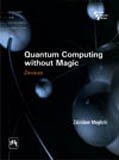Quantum Computing Without Magic Devices - Softcover
Book 18 of 27: Scientific and Engineering Computation
Synopsis
This text offers an introduction to quantum computing, with special emphasis on basic quantum physics, experiments, and quantum devices. It explains the requisite quantum physics in some depth, and then explains the devices themselves. Quantum Computing without Magic covers the essential probability calculus; the qubit, its physics, manipulation and measurement, and how it can be implemented using superconducting electronics; quaternions and density operator formalism; unitary formalism and its application to Berry phase manipulation; the biqubit, the mysteries of entangle- ment, nonlocality, separability, biqubit classification, and the Schroedinger's Cat paradox; the controlled- NOT gate, its applications and implementations; and classical analogs of a quantum devices and quantum processes. Quantum Computing without Magic can be used as a complementary text for physics and electronic engineering students studying quantum computing and basic quantum mechanics, or as an introduction and guide for electronic engineers, mathematicians, computer scientists, or scholars in these fields who are interested in quantum computing. "Quantum Computing without Magic gives a refreshing and down-to-earth approach to quantum information as well as quantum devices, which will have a fundamental impact on the technology of the twenty-first century." ?RAYMOND LAFLAMME Canada Research Chair in Quantum Information and Director Institute for Quantum Computing University of Waterloo Table of Contents Series Foreword. Preface. Bits and Registers. The Qubit. Quaternions. The Unitary Formalism.
"synopsis" may belong to another edition of this title.

